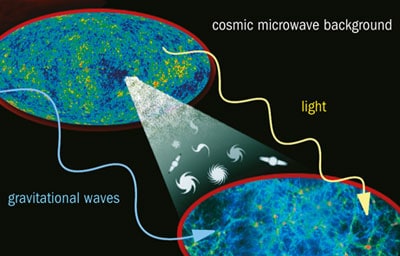
The first evidence for the primordial B-mode polarization of the cosmic microwave background (CMB) has been detected by astronomers working on the Background Imaging of Cosmic Extragalactic Polarization (BICEP2) telescope at the South Pole. The polarization signal is the first direct evidence for cosmic inflation and has been measured to a statistical certainty of 3σ. The primordial B-mode polarization is related to primordial gravitational waves that are thought to have abounded in the early universe.
Cosmologists believe that when the universe was very young – a mere 10–35 s after the Big Bang – it underwent a period of extremely rapid expansion, known as “inflation”, when its volume increased by a factor of up to 1080 in a tiny fraction of a second. About 380,000 years after the Big Bang, the CMB – the thermal remnant of the Big Bang – came into being. Over the years, the CMB has been measured with great accuracy, but these observations brought some problems: the CMB showed that the entire observable universe seemed to be homogeneous, flat and isotropic, while the physics of the Big Bang suggests that it should be highly curved and heterogeneous.
Inflation was first proposed in 1980 by the physicist Alan Guth, and is currently the best way to resolve these conundrums. It suggests that the entire observable universe originated in a small causally connected region that expanded at an exponential rate so that the horizon became much larger and space could be flat. Inflation also serves the purpose of ironing out any anisotropies or curvature of space, putting the universe into a rather simple state that is only mildly pertubated by quantum fluctuations. Such fluctuations are thought to have occurred in a “microscopic inflationary region” that eventually magnified to cosmic size, becoming the seeds for the growth of structure in the universe – everything from stars to galaxies. There are also variations in temperature of about 100 µK in the CMB (which is normally at an even temperature of 3 K), which reveal density fluctuations in the early universe.
Extreme gravitational conditions
Scientists also believe that rather extreme gravitational conditions prevailed during the universe’s infancy. Gargantuan primordial gravitational waves are thought to have propagated through the universe during the first moments of inflation and this would have produced a so-called cosmic gravitational-wave background (CGB). This gravitational-wave background would, in turn, have left its own imprint on the polarization of the CMB – a sort of “curl” component or rotation that is known as the primordial B-mode polarization.
This is why researchers the world over have been keen to detect the primordial B-mode polarization – it would be evidence of primordial gravitational waves and so inflation. And it is this B-mode polarization that the BICEP2 collaboration has detected for the first time. There is also another similar component known as non-primordial B-mode polarization, which is caused by gravitational lensing, and this was detected last year by the South Pole Telescope (SPT). There are also other polarization variations, known as E-mode or gradient variations, that describe how the magnitude of polarization changes over the CMB.
Scientists cannot distinguish between the polarization caused by gravitational waves, which has a tensor component, and that caused by density waves, which have a scalar component, simply by looking at the temperature variations of the CMB. Also, the primordial B-mode polarization is thought to be much weaker than the E-mode, making it even more difficult to detect. However, certain measurements on the polarization angles that can be detected at each point on the sky provide extra information and allow scientists to differentiate between the tensor and scalar components, providing a “tensor-to-scalar” ratio. This ratio has been measured by BICEP2 to be 0.20 with a statistical significance of about 3σ. The possibility that the ratio is zero is ruled out with a statistical certainty of 7σ.
A value of 0.20 is considered to be significantly larger than that expected from previous analyses of data from the Planck and WMAP telescopes. “This has been like looking for a needle in a haystack, but instead we found a crowbar,” says BICEP2 co-leader Clem Pryke of the University of Minnesota. Craig Hogan, director of the Fermilab Center for Particle Astrophysics, told physicsworld.com that “If it’s confirmed, it is truly profound – the first direct evidence not only for inflation, but of a quantum behaviour of space and time. The image of polarization is a relic imprint of roughly a single quanta of graviton action.”
According to the BICEP2 collaboration, its results suggest that “the long search for tensor B-modes is apparently over, and a new era of B-mode cosmology has begun”.
The BICEP2 results are available here.
- In this video Andrew Jaffe of Imperial College London explains why cosmologists believe that the universe underwent a period of vast and raid growth when it was just fractions of a second old.
Read more
- Sounding out the Big Bang
- Inflation, strings and the anthropic principle
- What is cosmic inflation?
- Planck perspectives
- WMAP data put cosmic inflation to the test
- B-mode polarization spotted in cosmic microwave background




